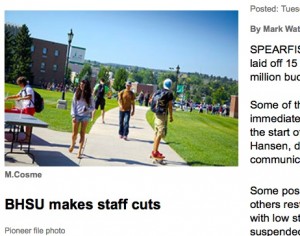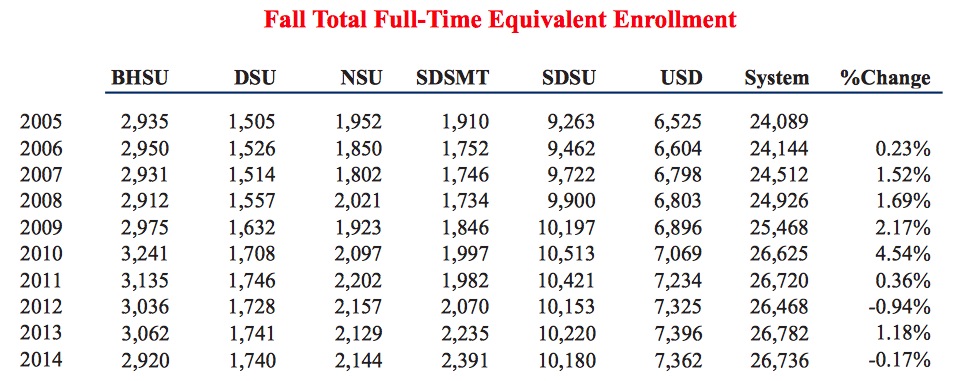
The Board of Regents’ FY 2015 Fact Book (page 14) says that 4.3% of all of South Dakota’s Regental undergrads and 6.3% of those enrolled at Black Hills State University are under age 18; we may assume that the majority of those students are dual credit-takers. Alas, BHSU implicates dual credit in the $1.5-million shortfall that has led the Spearfish campus to lay off fifteen employees:
“The deficit is from the decline in credit hours,” Hansen said. “Part of our budget comes from credit hours. Our overall credit hours have decreased even as our headcount has increased.”
In 2008, students took a total of 90,908 credit hours. In 2011, that number jumped to 98,176 credit hours and has fallen annually to 91,261 credit hours in 2014.
Hansen said that the increase in total number of students comes in part from the dual enrollment of high school students who are able to take university courses at a greatly reduced rate. Those courses count toward their high school diploma as well as their college transcript.
“We had a high number of high schoolers participate in (dual enrollment), which is great, but they are only taking one or two classes. Even though they show up as a head count in our enrollment, their credit hours are not that of a full student,” she said.
Most fulltime students take 15 credit hours [Mark Watson, “BHSU Makes Staff Cuts,” Black Hills Pioneer, 2015.03.03].
Sure: if students can get cheaper credits during high school, they won’t need to pay for as many full-time credits when they’re on campus. But remember that the Regents reduced the number of credits required for graduation from 128 to 120. That cut means students need one less credit (15 instead of 16) each semester for full-time enrollment. (But hey: now you can’t accuse the Regents of just trying to squeeze more money out of students.)
The bigger problem seems to be that full-time equivalent enrollment has settled back to the pre-recession level at BHSU. Again, from the BOR FY2015 Fact Book (p. 13):
Notice that BHSU’s FTE enrollment has dropped since peaking in 2010, while enrollment down the road at School of Mines has jumped notably. BHSU mentions in Watson’s article that its enrollment numbers from the Northern Hills and Rapid City are “really pretty soft,” but that harder school less than an hour away in Rapid City isn’t having trouble attracting new students.
Mentioning dual credit as part of budget woes contradicts the marketing advantage of the program. Dual credit provides the universities a chance to get their hooks in promising students—you’ve already earned a semester or two of credits at BHSU; why not enroll full-time and finish your degree here after graduation? If I were working admissions, I’d promote the heck out of dual credit as a recruiting tool.
Dual credit serves ambitious South Dakota high school students well; it can also serve our universities as they work to boost their full-time enrollment.

66 county seats and 6+ four year universities: how South Dakota became a red moocher state.
I’m sure that brand new house they built for the BHSU president didn’t add to this problem.
Hi everyone. I am a professor at BHSU and wanted to clarify a few points.
1. Perhaps there was a misunderstanding regarding the point of including the dual-credit discussion in the BHSU press release. It sounds to me like BHSU wasn’t criticizing the dual-credit program, it simply included the information to explain why the head count numbers appeared fine but the credit generated numbers were down – because high school students don’t enroll for a full load but are included in the head count.
2. BHSU is extremely active in supporting the dual-credit program and recruiting dual-credit students for our classes – it has the second highest number of dual-credit students in the system. In fact, 15 of the 25 students enrolled in my online POLS 100 class this semester are dual-credit students. In some ways, our commitment to this program hurts us in the short term because the state doesn’t fully make up the tuition difference for these students. That said, I wouldn’t change a thing – I think it is a great program.
3. This might be a good opportunity to point out that BHSU receives less money per student from the state than any other university in the system. Only 18% of the BHSU budget comes from state support money. Thus when our credit hours decrease we really feel it because we rely on tuition money more than the others.
Cory, of course the answer would simply be to raise the cost for a dual credit.
And the thing about BHSU, I’m still pissed at em for dropping the C, and adding the U. But then thats just me.
I dont know what its worth, but it appears that it isn’t just the northern hills that have gone soft on BH–. It looks like a lot of people that would have gone to Spearfish ten years ago are making plans to go elsewhere.
I’m sure that some of this is money. East river kids staying closer to home would explain part of the bigger schools gains on the east side of the state. And maybe there’s been some comparing of notes and everyone is finding out that not every institution of higher learning should be called a university. Some in fact should be colleges.!
The Blindman
Blindman, I feel the same about my alma mater changing the “C” to a “U”. Northern is not a university. Neither is BHSC or DSC. I’ll allow the “U” designation for Vermillion and Brookings.
About full-time students. I wonder how much of that is due to students who cannot afford to go to school full-time? They have to work to make ends meet. The new minimum wage law may actually help with college student numbers. Unless the legislature screws it up even more.
Thanks for that clarification Prof. Carriveau. The use of dual credit classes among high schoolers is really taking off throughout the country. The future tuition savings for those students is really wonderful for them. I admit I hadn’t thought about the revenue decline for higher education institutions.
I’m living in MN now and state government has been increasing their support of higher education by raising the amount of money going to the U of MN and the rest of the state’s schools in what is known as MNSCU, Minnesota State Colleges and Universities. Member institutions have been keeping tuition flat since 2013 as a result.
Of course, MN has a Democratic governor and Democratic state Senate. Previous to the last election, the state House was Democratic too. Makes a huge difference in priorities.
Do you see a way to find the willingness in Pierre to make similar adjustments in funding choices?
Deb, I doubt Pierre has much interest in making people smart, smart people don’t vote republican.
Tim,we’ll soon find out whether unions in Wisconsin learned their lesson about trusting Walker’s word. Walker promised some unions that right to work legislation would not reach his desk and if it did he would not sign it. This was during last fall’s election campaign. You can read the rest here- http://host.madison.com/ct/news/local/govt-and-politics/election-matters/plain-talk-let-s-call-gov-walker-what-he-is/article_05328ba4-ad1b-52b2-abcc-1e9e4ae58979.html
Mike, I have said repeatedly, never listen to what they say, watch what they do.
Tim, I agree with both your comments. I apply the “Watch what they do” adage to everyone. Once the individual has proven herself, I’ll begin to trust her. The ones who say, “Trust me, ” are the most suspect.